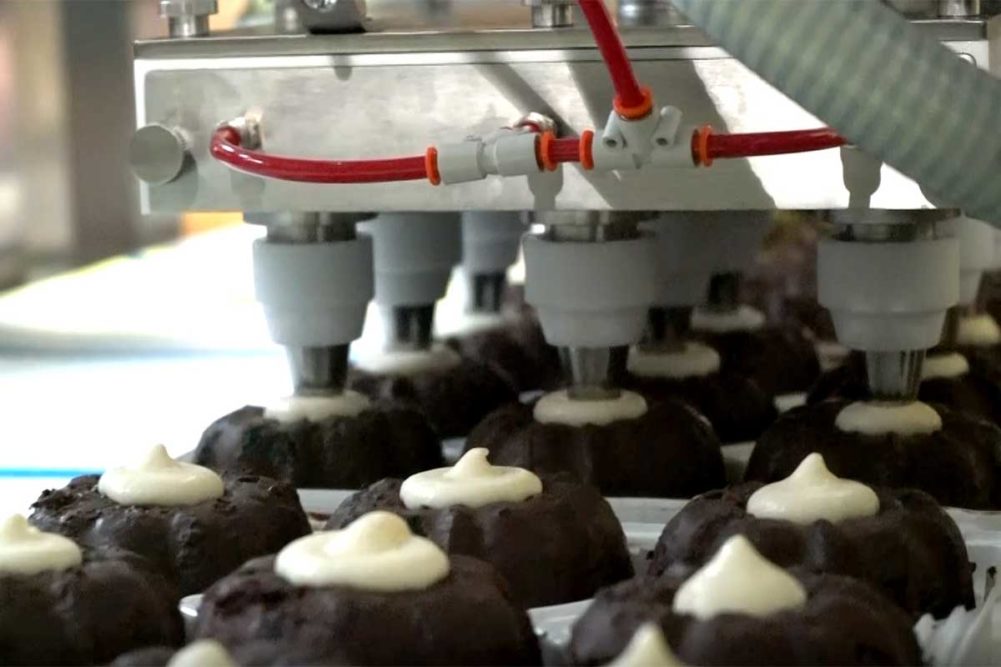Reducing even small amounts of wasted glaze on high-speed lines will result in significant savings in a short period of time.
That’s why Burford Corp., a Middleby Bakery company, combines its Model V1000 Vision System with its Model 824-03 Spray Applicator with spot spray system to increase the accuracy of glazing on high-speed bun lines, said Josh Hughes, sales account manager, Burford.
“Applying glaze where it is not needed or wanted equals wasted dollars in the form of wasted glazing and increased sanitation costs,” he explained. “Together these systems minimize overspray and avoid applying glaze to empty or overfilled pan pockets.”
Meanwhile, AMF Tromp’s Target Glaze unit applies the spray precisely on baked products without producing a mist of glaze or creating messy pans, according to the company. The system can handle 4,000 to 24,000 products per hour.
For glazing, the focus is reliability, flexibility and accuracy, said Norm Searle, sales and marketing, GOE/Amherst Stainless Fabrication.
“Systems preferably should accommodate a range of viscous glazes, including those with inclusions,” he said. “Having the flexibility to apply glaze to the top, bottom and sides of a product is a bonus. Temperature control and recovery of unused glaze are also keys to operating a profitable production line.”
Mr. Searle also advocated minimizing changeover time, whether it’s for maintenance or because the operation intends to run a different product.
“Downtime affects cost, schedules are interrupted, shipments are delayed,” he said. “Flexible system design affords less downtime during changeover and minimal operator training.”
Overall, bakeries that use high-value toppings, icings and glazes may see the quickest returns on investments, although the ROI ultimately depends on the operation.
For instance, Axis Automation developed a glaze recovery system that not only reduced the amount of glaze the bakery consumed, but it also transferred less residual glaze downstream to other equipment, noted Chuck Sena, director of sales and marketing for the company.
“When the system was up-and-running, the baker discovered that the savings from downtime and sanitation with this reclaim system would have justified the original project all by itself,” he said.
Mr. Sena stated precision not only means less waste, but also provides quality control. Inconsistent depositing, for instance, results in a wider range of weight variations between products.
“Many bakers compensate for underweight products by setting tolerances that effectively ensure a certain amount of product giveaway,” he explained. “Using precision equipment allows bakers to tighten this window, reducing the potential amount of product giveaway and scrap due to underweights. Similarly, a consistent application of materials ensures a uniform appearance, which reduces scrap caused by non-conformance.”
John McIsaac, vice president of strategic business development for Reiser, recalled that bakers at last year’s International Baking Industry Exposition and other trade shows searched for systems that provided greater flexibility.
“They want equipment that can run a variety of today’s products and tomorrow’s,” he said. “Advances in our double-screw portioning system are allowing us to portion more delicate products and bigger inclusions gently and with high accuracy.”
Mr. Sena pointed out two ways that equipment can provide versatility on a production line. One option is to allow bakers to run a wide range of products and formats with a single machine. A second method is to quickly change out machines to reconfigure the line.
He said the Axis LD Depositor, for instance, can wire cut cookies, deposit brownie batter in cavities on a pan or continuously extrude batter onto pans or an oven band.
“This gives bakers the ability to make a wider range of products on a single line with minimal downtime for changeover,” Mr. Sena noted.
Axis Automation also incorporates a standardized rail and transfer cart system to allow equipment to be swapped out quickly. Another option involves using equipment as modules on a production line.
“In this approach, each machine includes an integrated conveyor, and each of the conveyors for the different modules are the same length,” Mr. Sena said. “This approach makes it easy to move equipment around to adapt to dispensing batters, toppings, frosting and other finishes in a different sequence.”
He added the equipment rests on casters and uses quick connectors and communication over ethernet, which also allows bakers to use the same piece of equipment on several production lines, if needed.
In today’s challenging market, midsize bakers and producers of premium products can hit it out of the park with automated depositing, icing and glazing systems that minimize waste and boost capacity with less labor in the long run.
This article is an excerpt from the July 2023 issue of Baking & Snack. To read the entire feature on Depositing, Icing, Glazing, click here.






